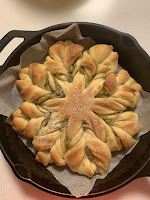Rice - Our Staple Food
If you have read my previous articles on Japanese Food, you might notice that there is a common ingredient in both onigiri and mochi; and that is, RICE. Rice is a staple food worldwide, especially in Asian countries. Long grain, short grain, jasmine, glutinous rice, brown rice, purple rice, etc. make the variety of rice so rich and extensive that are then used by each country to create its own signature rice dishes, both savory and sweet. In Europe, we have risotto in Italy, paella in Spain; in Asia, we have sushi, onigiri, donburi in Japan, our HK popular rice dish is called 碟頭飯 deep tou fan (it is similar to donburi but it's usually served on a plate in a Cha Chaan Ten - HK style restaurants), fried rice (yinyan fried rice and Hokkien fried rice are my favourite rice dishes!), dosa and biryani in India, bibimbap and kimbap in Korea, nasi goreng in Malaysia, even loco moco in Hawaii...etc.
Rice provides our body the source of energy in the form of carbohydrate, and different types of rice have their own nutrition values, providing nutrients such as B vitamins, potassium, fiber etc. As all dietitians and medical professionals would recommend, instead of white, whole grain should be consumed more often because of its ample amount of dietary fiber. At home, I cook my rice with a mixture of brown rice 玄米 (げんまい)20% and white rice 80% (preferably all brown rice though), sometimes I add rolled oats to enhance both the nutrition values and the texture.
If you wonder how and what Hong Kong family cooks for dinner, here are some photos of our dinners recently while Daddy is in Germany:



*We usually have 2 meat dishes and 1 vegetable dish to be shared, and a bowl of rice for each of us. The rice on plate is what we called 碟頭飯 and the rice in bowl is called donburi. They are quick and easy to prepare.
Many people nowadays purposely omit "rice" in their diet because of their perception of weight gain. Remember, rice doesn't make you fat or make you gain weight! It's all about the way you prepare and the amount you consume. Many clients I had previously had such perception, in fact they tended to consume more of the other food groups typically meat, in order to feel satiety. Meat has fat in it, even though it's very lean. If you are still struggling about consuming rice, try to incorporate other kind of starch (complex carbohydrate) like pasta, soba noodle, potato, sweet potato, oatmeal, etc. in your diet gradually. *Healthy cooking methods apply.
In order to have a balance meal, we need to have starch (in this case, rice) + protein (meat / tofu / fish) + veggie!


















